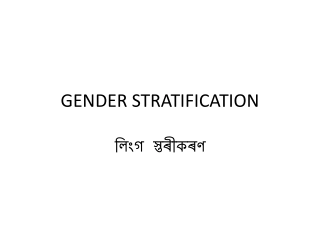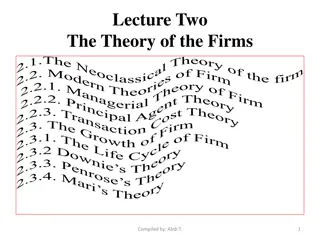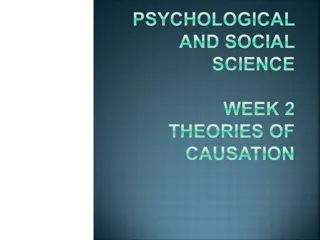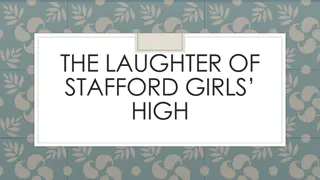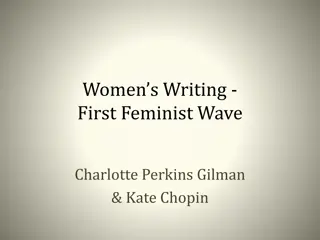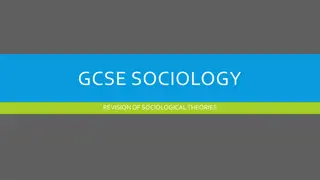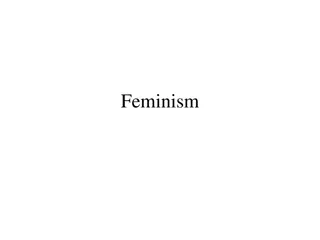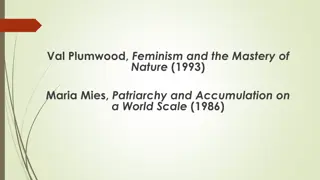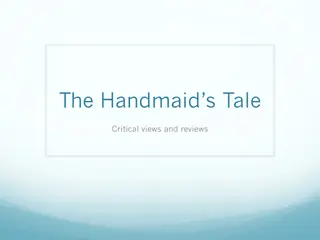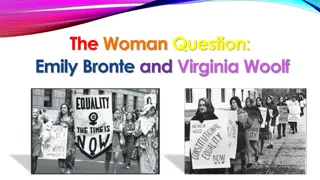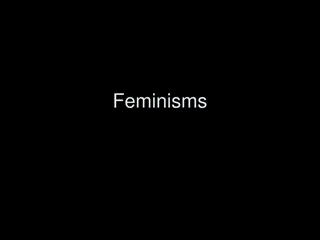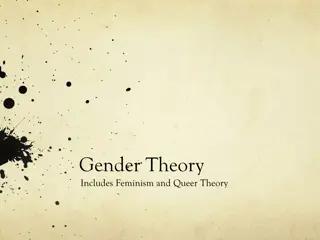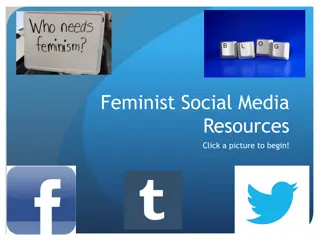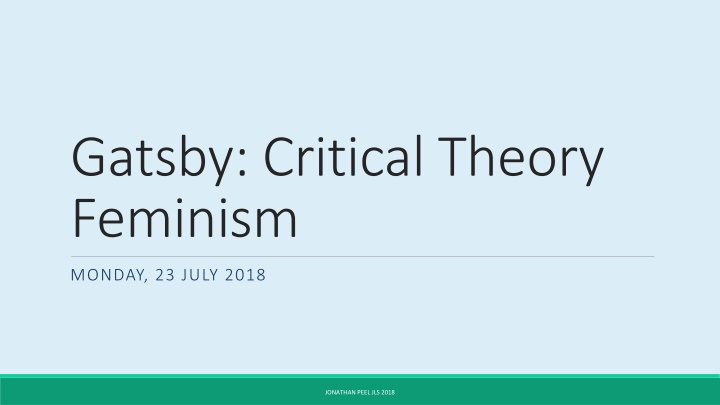
Feminist Critique of Literature through Patriarchal Lens
Explore feminist perspectives on literature, analyzing how patriarchal ideologies shape portrayals of women and influence cultural norms. Delve into the intersectionality of gender, race, religion, and culture in women's experiences.
Download Presentation

Please find below an Image/Link to download the presentation.
The content on the website is provided AS IS for your information and personal use only. It may not be sold, licensed, or shared on other websites without obtaining consent from the author. If you encounter any issues during the download, it is possible that the publisher has removed the file from their server.
You are allowed to download the files provided on this website for personal or commercial use, subject to the condition that they are used lawfully. All files are the property of their respective owners.
The content on the website is provided AS IS for your information and personal use only. It may not be sold, licensed, or shared on other websites without obtaining consent from the author.
E N D
Presentation Transcript
Gatsby: Critical Theory Feminism MONDAY, 23 JULY 2018 JONATHAN PEEL JLS 2018
One is not born a woman, one becomes one : Simone de Beauvoir. Feminism is not about men. As De Beauvoir suggests, it is culture which serves to define the feminine, rather than biological sex. We should focus therefore on how a text reinforces and undermines the political, social, economic and psychological oppression of women. Thus we should consider the Patriarchal Agenda prevalent in any text we are reading. Few readers find any of Daisy, Jordan or Myrtle sympathetic. I have not in the past, yet we must also recognise the agenda prevalent in the writing which leads to these portrayals. There is no single form of Feminism and I am not trying to present an overview of that rich area. I am guided by this text: JONATHAN PEEL JLS 2018
Canon a Patriarchal construct Certainly until the 60s, Dead White Men were chosen by Living White Men to present a Universality in Literature. This has led to a habit of seeing in which the few women portrayed or presented for study are generally seen through a male lens. The works granted universality and thus worthy of study rarely reflect anything other than a male point of view. We might consider even now how few female writers are offered in examination set-text links at A level JONATHAN PEEL JLS 2018
Traditional Gender Roles Male: Strong, defender, rational, stoic, brave, decisive, breadwinners, sexually promiscuous (stallion) Female: Weak, submissive, emotional, hysterical, fearful, nurturing, sexually promiscuous (whore) (all reinforced culturally by fairy tale - part of the earliest cultural capital a young girl takes on). All are reinforced by a Patriarchal Agenda evident in the creation of the work studied. A male POV reinforces this even in movies the camera is so often male in perspective as it lingers on the curves and sensual positions inhabited by the female figure of its focus. JONATHAN PEEL JLS 2018
Feminist Premises 1. Women are oppressed by Patriarchy: economically, politically, socially and psychology. This is reinforced by Patriarchal Ideologies. 2. Women are objectified/marginalised by their non-adherence to male norms. She lacks what men have . 3. Most Western Society is founded upon deeply Patriarchal models. 4. Biology determines sex; culture determines gender. Thus behaviour (masculine/feminine) should not be defined by sex (male/female) 5. Promotion of women s equality in all areas of life JONATHAN PEEL JLS 2018
Questions a feminist critic should ask of a text 1. What is revealed about the operations of a patriarchy: how are women portrayed? Does the work undermine or support a patriarchal ideology? 2. How does race/religion/culture intersect with gender to shed light on women s experience? 3. How does the work define gender? Do all conform to the stereotypes of their sex as required? Does the text question these behaviours? 4. Does the text present any notion of a sisterhood to fight the patriarchy? 5. Does reception of the work reflect attitudes to Patriarchy? 6. What role is placed on the text in terms of literary history or literary tradition? JONATHAN PEEL JLS 2018
The Great Gatsby Tom spouts gibberish when he tells the reader that the structure of society rests on a stable patriarchal family, shortly after he discovers Daisy s infidelity. Nick uses this term, so we might expect him to show similar disdain for other aspects of a Patriarchal Agenda. But, time and again, the sympathetic narrator places the NEW WOMAN of post-war USA into a negative position. Post-war, women received the vote, changed their fashions and achieved undreamed of levels of freedom. The conservative voices of both genders saw this as the introduction of steep moral decline. The shift away from the 19th Century demure, modest woman-at-home seems to be the focus of the Patriarchal Agenda at the heart of Nick s narration. JONATHAN PEEL JLS 2018
Minor women At the parties we meet innumerable minor characters mostly female and of these, nearly all New Women. Mrs McKie might be the only real contrast. Since we sympathise with Nick, his harsh criticism sticks: at Gatsby s parties women are drunken, self-promoting, vacuous, narcissistic, hysterical and untruthful by turns. Dishonesty in a woman is a thing you never blame deeply says Nick, showing a condescending attitude to his subject and reinforcing the gender-smear that all women are dishonest which goes right back to Eve. Catherine is portrayed as a loud, opinionated, foolish liar she claims not to drink and is drunk in the garage and her description of the trip to Monte Carlo is simply absurd in its mixture of licence and naivety. We may see these as classist criticisms, but to do so is to ignore the positive depictions of male members of the lower classes such as Michaelis. JONATHAN PEEL JLS 2018
The New Women Daisy, Jordan and Myrtle all embody the New Woman : 1. 1 child between them, despite two marriages suggest a disregard for the nurture role 2. All seek to break out from the home and seek excitement elsewhere 3. All are sexually precocious either in affairs or in pre-marital sex Their freedom is replicated in negative character traits: Daisy: Selfish, cruel and affected. Lacks evident moral compass. Jordan: Selfish, cheat, liar, gossip. Shirks responsibility for her actions she has to cheat to succeed in a man s world. Has taken male attributes of appearance. Myrtle: Loud, sexually active for fun and pleasure, affected. JONATHAN PEEL JLS 2018
New Women are punished a message to all? Daisy: punishment is to stay with Tom a serial adulterer and bully. She will move back to Mid West and lose chance to be accepted into East Coast society. Jordan: Dumped by Nick who tells us about her claims to be engaged and a lack of care about him as a means to show her having been brought down a peg by his actions. Myrtle: The strongest punishment for the worst offender . She dies a brutally sexualized death. She represents the strongest threat to the Patriarchy a woman who cheats for fun and seeks to overmaster her husband. She is brutally struck for taunting Tom at which point the males disengage Mrs McKie and Catherine are left to clean up. Women are not relevant in their lives and there is no criticism of this from Nick. Myrtle is not bad, per se she is a threat. Such sexual openness must be discouraged. JONATHAN PEEL JLS 2018
A Patriarchal Agenda? Women are portrayed negatively. They are seen as liars, cheats and immoral- they pose a threat to the Patriarchal World Order so beloved of Tom. Nick s attitudes do little to suggest that he sees women as equal in any sense. Thus the text can be read as a warning about the dangers of the rise of the New Woman and a wish to turn back the clock and to return to the world of pre-war Mid-Western family values. JONATHAN PEEL JLS 2018

